
Architectural rending of The Griot and The Historic Garfield apartments with the rebuilding of America’s Black Holocaust Museum in the foreground. Courtesy of Mauer Development Group, LLC and J. Jeffers & Company
MILWAUKEE – Tuesday, April 4, proved a banner day for this city’s deep memory, brave hope and authentic culture. It was the groundbreaking day for The Griot and Historic Garfield Apartments, one of the most historically fraught, and socially and culturally inspired development projects Milwaukee has seen in a long time. The centerpiece of the project will be the reconstruction of America’s Black Holocaust Museum, at the corner of North Avenue and Fourth Street.
It signifies great pride in how the city has embraced and burnished its memory of what is now called Historic Bronzeville, a vibrant cluster of Harlem Renaissance-like inner-city neighborhoods (bounded by N. Holton St., E. Juneau Ave., N. 21st St. and Burleigh St.) in the postwar period, which is working mightily to regain its luster.
More pointedly, it is also a matter of honor that the project will be nobly shadowed by the profound history the museum will reawaken for all visitors. This location is the site of the original museum founded by a remarkable man for anyone who knew him, Dr. James Cameron, the only survivor of a lynching to do full justice to that dark chapter of America history with an autobiography and a museum dedicated to remembrance of great suffering, deliverance and ongoing affirmation of African-Americans from The Middle Passage to The Civil Rights Era and doubtlessly to today’s Black Lives Matter movement.
An overcast day drew at least 400 people to a large tent that has been erected as the spring shelter for the construction project, behind the historic Garfield Street Elementary School around which the project will be built.
Besides the projects organizers those in attendance included Mayor Tom Barrett, alderpersons Milele Coggs and Nick Kovac, and other notables. Barrett and Coggs spoke in support of the project. One of the project’s founders, Melissa Goins, of the Maures Development Group LLC, also spoke and suggested that it would “break the heart” of Museum’s late founder Dr. Cameron if – after all his work, including his remarkable autobiography, A Time of Terror: A Survivor’s Story – the museum had no physical afterlife following its closing in 2006, due to financial difficulties. Dr. Cameron was acknowledged symbolically at the groundbreaking with an empty chair near the podium.
 Alderwoman Milele Coggs (L) and Maures Development Group’s Melissa Goins proudly announced the historic redevelopment project in May 2016.
Alderwoman Milele Coggs (L) and Maures Development Group’s Melissa Goins proudly announced the historic redevelopment project in May 2016.
Spoken word poet Dasha Kelly delivered a lovely and inspiring poem which welcomed the rhythms and passages of the seasons and exhorted the audience with these words “You be the rain. Make the gray clouds move,” which drew a strong applause from the audience in the spirit of the event’s underlying objective: to request the community to move the earth with their finances for what will be a multi-million dollar, multipurpose project.
Following the presentation, a local jazz band, Cigarette Break, performed during a luncheon.
The historic Garfield Elementary School Building will be reborn as The Historic Garfield Apartments with 30 units of high quality apartments. In phase 2, the adjoining vacant properties will be demolished developed as The Griot, a new building with 8,000 ft. of commercial space and 41 residential units. Both buildings will have a combination of one, two and three-bedroom apartments targeting households at 30%, 50%, and 60% of area median income as well as market rate. The Griot will also become home to the new physical building for America’s Black Holocaust Museum (ABHM). *

The historic former Garfield Elementary School building (left) will be redeveloped and repurposed for 30 units of high-quality, mixed-income housing. Courtesy of Mauer Development Group, LLC and J. Jeffers & Company
And it appears that this project will be realized primarily by the city’s citizenship, and various corporate funders and benefactors as have other notable cultural entities such as the Milwaukee Art Museum’s internationally-celebrated Calatrava addition.
Speaking of internationally-celebrated cultural institutions, there’s no doubt that the National Museum of African-American History and Culture in Washington, though wider ranging, which has James Cameron’s museum as a historic model, proved to be an inspiration for this project.
Conceptually the museum will be built on a pillar of four themes: Remembrance, Resistance, Redemption, and Reconciliation, which are expanded upon in the excellent online version of the museum edited by Fran Kaplan PhD. at America’s Black Holocaust Museum.
My own interest in the museum dates back a number of years to when I discovered it accidentally while driving through the Bronzeville neighborhood in hopes of visiting the facility that formerly housed Radio Doctors “Soul Shop,” a music store that I worked at in the 1970s. The space was located a block away from the site of the Holocaust Museum (see photo below). The site of record store, which served Milwaukee’s inner city, was merely an empty lot at the time.
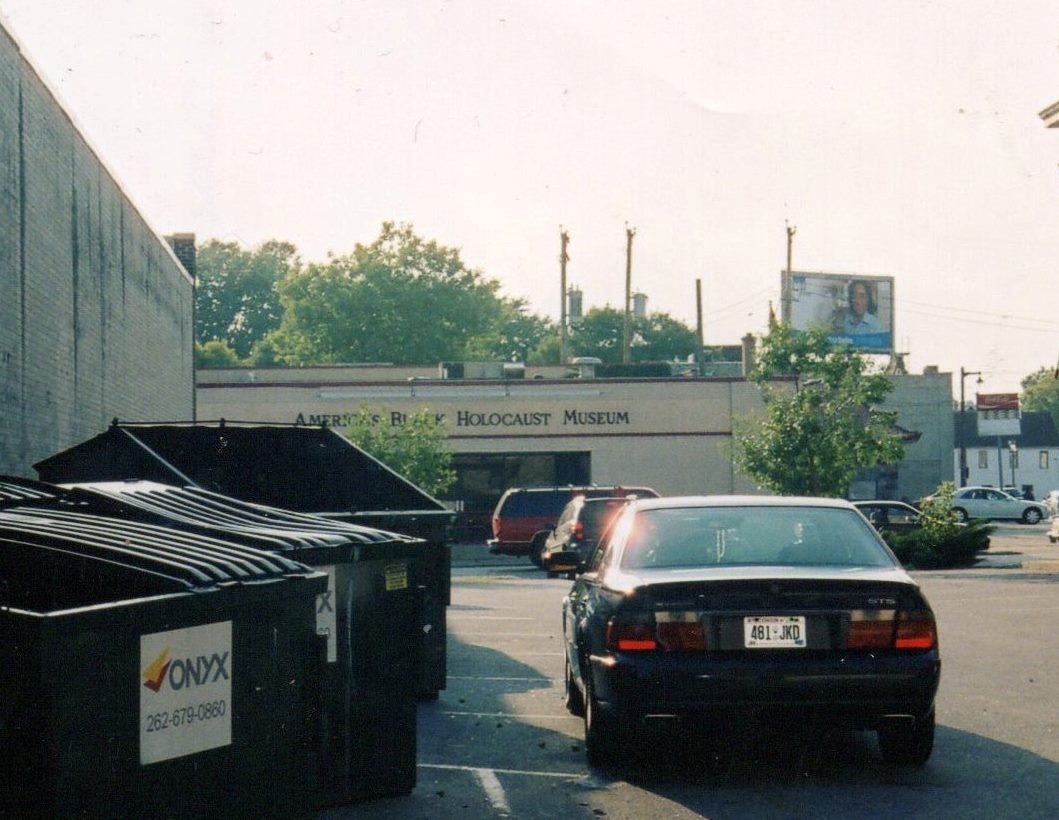
Photo of the original America’s Black Holocaust Museum (in background) from the empty lot on 3rd and North Avenue where once stood Radio Doctor’s “Soul Shop,” a record store were I once worked. Photo By Kevin Lynch
But I visited the museum and was greatly impressed, which prompted an interview with Dr. Cameron which was originally published in The Capital Times in Madison and later became part of the chapter of my forthcoming book Voices in the River: The Jazz Message to Democracy.
Here is an excerpt from a chapter that deals with the Holocaust Museum and Dr. Cameron.
“The Man Who Survived a Lynching,” from Chapter 11 of Voices in the River: The Jazz Message to Democracy. Copyright Kevin E. Lynch 2017
One overcast summer day in 1999, I felt that chilled American duality between constitutional guidelines and the individual voice in the wind that swept through the empty lot of my old workplace haunt, Radio Doctors “Soul Shop” in Milwaukee’s inner city. A few foundation bricks still remained among weeds and a crooked dirt path to the back alley where we once unloaded truckloads of records. There I saw a pile of debris that looked like the site of a drug fix, “with needles on the ground,” as The Tedeschi-Trucks Band sings in “Midnight in Harlem.”
And with the watery ghosts dwelling in this book, it’s seems wholly fitting that the setting TTB’s songwriter for this melancholy scene is a river side, (presumably The Hudson River) in what emerges as a potentially redemptive lyric:
…I went down to the river
And I took a look around
There were old man’s shoes
There were needles on the ground
No more mysteries, baby
No more secrets, no more clues
The stars are out there
You can almost see the moon
The streets are windy
And the subway’s closing down
Gonna carry this dream
To the other side of town.
Walk that line, torn apart
Spend your whole life trying
Ride that train, free your heart
It’s midnight up in Harlem 1
I almost felt renowned Harlem “survivor” James Baldwin’s large sad eyes casting a glance over my shoulder. But right then, having crossed the Milwaukee River a few blocks back, I was walking over to one of the nation’s most resolute beacons of understanding, America’s Black Holocaust Museum, on 4th and North Avenue, now just a windblown tumble of garbage away from the empty Soul Shop lot.
I’d come to visit with the museum’s founder James Cameron on the occasion of A Slave Ship Speaks: The Wreck of the Henrietta Marie, a harrowing exhibit of the most preserved and documented slave trade ship ever found in the Western Hemisphere. I stepped into the exhibit’s shadowy quarters. I touched the limbs of shackled museum dummy figures, heard recorded creaks and moans from the ship’s hull, and the sepulchral voice of an African recollecting the experience.
The small museum, the first of its kind, existed to convey a deep perspective on American racism. Yet he conveyed no animosity towards white people. “This is a museum for African-Americans and for freedom-loving people of all races,” Cameron said emphatically. He appreciates the significance of America’s little-known interracial foundation. Standard history rarely explains how free blacks actively participated in the formation of the thirteen colonies, until commercial dependency on slavery betrayed their place in America.
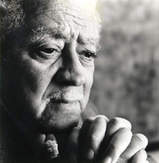
Dr. James Cameron, founder of America’s Black Holocaust Museum. Courtesy black-market.com who
Consider what even free blacks had likely endured to reach the colonies. On average, 20 percent of a slave ship’s human cargo died in the six-to-10 month, rat infested trip from Africa to America via the London market. Ships typically stopped at Caribbean ports for slave “seasoning,” to help them regain their health and acclimate to working conditions before they were presented for market.
The 85-year-old Cameron had returned to his hometown of Marion, Indiana the previous weekend to protest a Klan recruitment rally on the steps of City Hall. As he talked, Cameron gazed out the window, into nightmarish memories. In 1930, a Marion lynch mob seized three black teenagers, including Cameron, who had been accused of robbing and murdering a white man and raping a white woman. Confessions were apparently coerced, according to writer David Bradley, author of The Chaneysville Incident, another bleak chapter in race history. 2
Imagine the horror of the 16-year-old Cameron, as the slobbering, sledgehammer-and crow bar-wielding mob apparently smashed the jail bars open wide enough to drag him and his friends out to a nearby poplar tree. Cameron turned back to me and said: “A miracle saved me. They were going to lynch me between my buddies.” The mob of about 5,000 was “hollering for my blood” when an angelic woman’s voice said, ‘Take this boy back.'”
He fell silent. Sometimes the truth comes out in dribs and drabs. In 1994 he had told NPR that the mob grabbed Shipp and Smith first — and then came back for Cameron.
“After 15 or 20 minutes of having their pictures taken and everything, they came back to get me,” Cameron said. “Just then the sheriff came, and he was sweating like somebody had throwed a bucket of water in his face. He told the mob leader: ‘Get the hell out of here, you already hung two of ’em so that ought to satisfy ya.’ Then they began to yell for me like a favorite basketball or football player. They said: ‘We want Cameron, we want Cameron, and we want Cameron.'” 3 Somehow, the mob relented and removed the rope from the boy’s neck. Yet Cameron was forced to stand beneath the hanging bodies of his friends, Thomas Shipp and Abraham Smith. Then, he barely survived a brutal beating, he said.
American griots and a photograph of the travesty by Lawrence Beitler helped fix the lynching in American history. The image is believed to have inspired Abe Meeropole to write the lyrics to “Strange Fruit,” which Billie Holiday made into the immortal jazz-protest dirge: “blood on the leaves and blood at the root/ black body swinging in the Southern breeze…” The photo became a post-card that sold by the thousands, burnishing local racist pride. Bob Dylan commemorated that ugly image in the first line of “Desolation Row.”: They’re selling post-cards of the hanging… The bizarre, carnivalesque quality of Dylan’s unfolding imagery suggests that this event helped trigger his vision of that metaphoric American place called “Desolation Row,” where young James Cameron once dwelled.

Patrick J. Sims, assistant professor of theatre and drama, rehearses for his one-person play, “Ten Perfect,” in Lathrop Hall at the University of Wisconsin-Madison on Jan. 15, 2010. During the play, Sims portrays 18 characters to tell the story of James Cameron, an African-American who survived a lynching as a teenager in Indiana in 1930. Sims’ public performance of the play is scheduled for Feb. 5-6, 2010, in Lathrop’s Margaret H’Doubler Performance Space.
©UW-Madison University Communications 608/262-0067
Photo by: Jeff Miller
Date: 01/10 File#: NIKON D3 digital frame 4272
This photograph by Lawrence Beitler in this theatrical backdrop, helped fix the 1930 Marion, Indiana lynching — which 16-year-old James Cameron barely escaped — in the consciousness of America.
Cameron was moved out of town, convicted as an accessory to the murder and served four years in jail. But the case was never solved.
“I talk to university professors of history who do not understand this,” said Cameron, who received an honorary doctorate from the UW-Milwaukee for his work as an historian. His understanding of the event is ontological. 4
Cameron struggled for years with the lightness of being – those hovering friends – as a near-victim of a rope’s twist of fate. Finally he mortgaged his house to print and publish his memoir, A Time of Terror. Then, after visiting Israel’s Yad Vashem Holocaust Memorial, he knew what he had to do. Moving to Milwaukee, he found an abandoned gym on 4th and North. He bought it from the city for $1 and began piecing together the museum, built around the Beitler photograph and the ripple effect of sea-born echoes. Cameron would found several chapters of the NAACP, and the museum. In 1993, he finally received an official pardon from Indiana Governor Evan Bayh, and one of those oversize “keys to the city” of Marion, perhaps the size of the lynch mob’s sledgehammer. Cameron said he broke down and cried when Gov. Bayh telephoned him. The United States Senate formally apologized in June, 2005, with Cameron present, for its refusal to approve any of the 200 anti-lynching legislation bills introduced during the first half of the 20th century, a failure that led to the deaths of at least several thousand African-Americans.
The following June, in 2006, James Cameron died. The museum closed in 2008, now a sad, shuttered building, like too many in Milwaukee’s inner city.
Life’s unbearable evanescence had swept over history once again. People die and their bones turn to dust. But legacies endure, like remnants of The Henrietta Marie — 300-year-old iron shackles, some small enough to entrap children’s wrists and ankles.
The mind of this haunted American griot worked his way through living hell and then rose slowly, against absurd odds, to the light of such a hard-won legacy. That’s worth lending a close ear, to a murmuring voice in the river, an American witness, survivor, and hero. “To pick up the loose threads of my life, weave them into something beautiful, worthwhile and God-like.” –James Cameron, The final sentence of A Time of Terror. 5
________________
(Scroll to more illustrations and a video, below footnotes)
* Historic Garfield Apartments will begin leasing in July 2017 and construction will be complete in October 2017. The Griot will begin leasing in December 2018 and construction completion is slated for March 2018. Located 1.5 miles from downtown along a major core commercial corridor, the project is aimed at helping catalyze local economy and create jobs and training opportunities. It promises to initiate the rebirth of the envisioned Brownsville Arts and Entertainment district.
1. Here is The Tedeschi-Trucks Band performing the quietly eloquent “Midnight in Harlem,” written by the band’s back-up singer Mike Mattison, at Eric Clapton’s Crossroads Blues Festival at Toyota Park in Bridgeview, IL. in 2010: https://www.youtube.com/watch?v=mqjD4oinpJA
- David Bradley, “Anatomy of a Murder,” The Nation, June 12, 2006: 32. Bradley was reviewing a book with an in-depth account of the Marion lynching, Our Town: A Heartland Lynching, a Haunted Town, and the Hidden History of White America by Cynthia Carr
3 http://www.npr.org/templates/story/story.php?storyId=129025516
- Kevin Lynch “Exhibit Gives Life to Ship of Slaves,” James Cameron interview, The Capital Times, 31 July, 1999 Lifestyle 1D.
5 James Cameron, A Time of Terror: A Survivor’s Story.
Here’s a link to the impressive online-only version of America’s Black Holocaust Museum, founded by James Cameron: http://abhmuseum.org/. The museum will be restored in a new building on the site of the original building at fifth Street and North Avenue in Milwaukee. Also, there is the Lest We Forget Slavery Museum in Philadelphia, a small Black Holocaust Museum in Detroit and most importantly the magnificent new Smithsonian Institution’s National Museum of African American History and Culture, in Washington, D.C.

Dr. Fran Kaplan discusses America’s Black Holocaust Museum with Congresswoman Gwen Moore (WI 4th District) and the staff of Congressman John Lewis (GA 5th District) in Washington, DC.
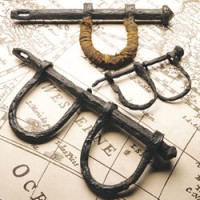
Shackles for women and children for the slaveship Henrietta Marie
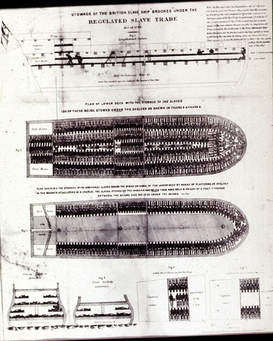
Illustration Courtesy virtualjamestown.org
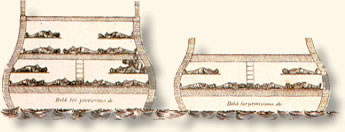
Original plans for holding slaves in sardine-like fashion in the ship during the Middle Passage (above and below).
Here is a compelling video of the Jim Crow Era set to a recording of Billie Holiday’s famous and harrowing anti-lynching song, “Strange Fruit.”
__________
All photos courtesy of abhm.com unless otherwise indicated

